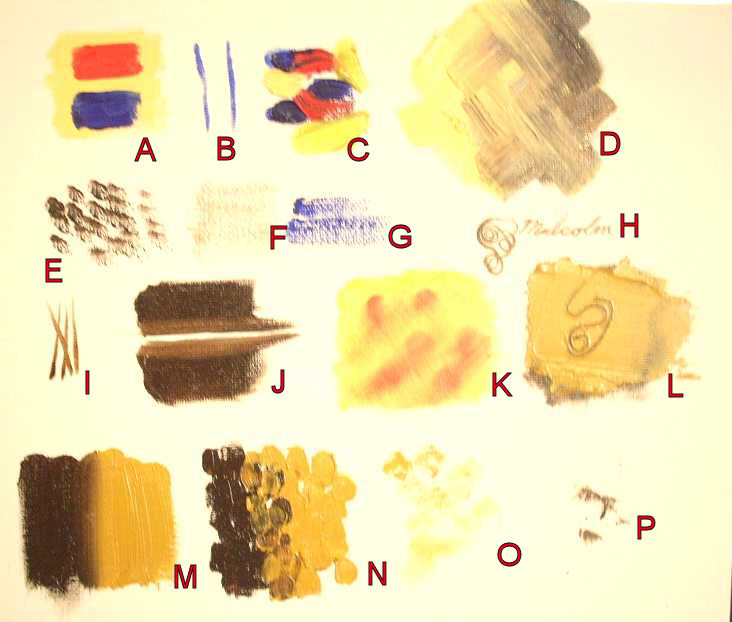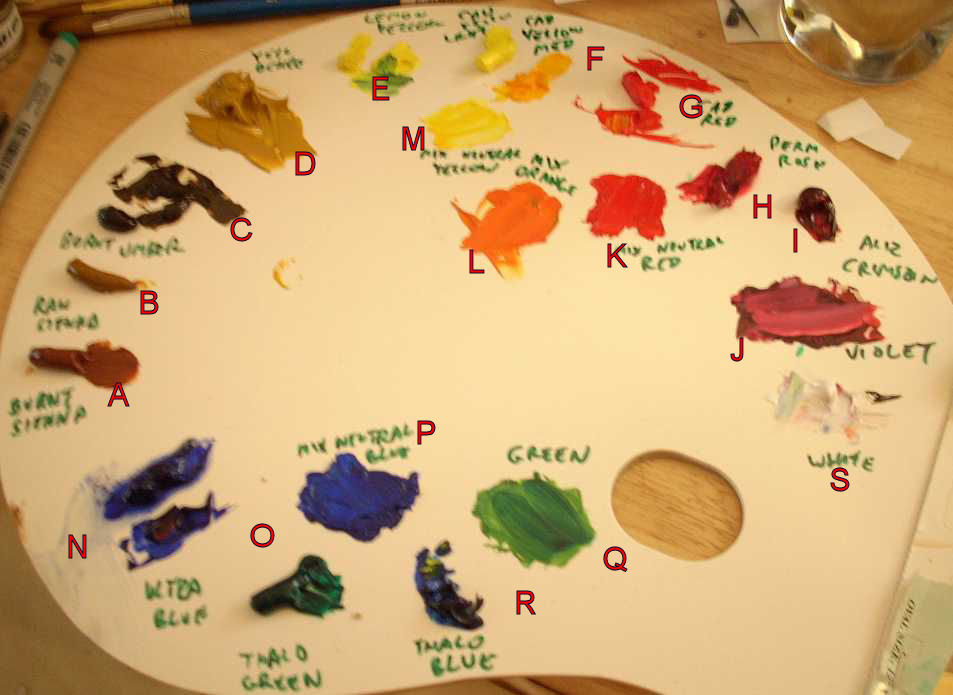
DAY ONE
LESSON 1: Brush strokes
For the first time, I learned the names of some of the brushes and their uses. I was stunned by what the shader could do and though I knew about dry brushing from painting miniatures, I never thought to apply it to oil painting. I don't think I'm bold enough to use impasto. Stippling would take a radical shift in my thinking too but this is a first step.
 |
A | Flat stroke with a flat bristle |
| B | Edge of flat bristle | |
| C | Impasto - dabbing with flat bristle | |
| D | Flip-Flop stroke - cross hatching with flat brush | |
| E | Stipple or Pounce with utility brush | |
| F | Dry brushing | |
| G | Scumbling - Passing over an area with a loaded brush | |
| H | Lines with fine point. Ink viscosity | |
| I | Weighted lines | |
| J | Angled shader brush used to redefine central line | |
| K | Hake Brush passing lightly over wet paint | |
| L | Light colour painted thick on dark and sharp end of brush carves lines | |
| M | A smooth blend with a flat bristle | |
| N | Bumpy texture blend using a #2 flat bristle | |
| O | Dabbing with paint on cloth | |
| P | Failed spray | |
LESSON TWO: The Paints
Finally I start to come to terms with colours and their uses. In the process, I learn to better understand their qualities. Never before had I laid out a full pallette and even something as simple as setting out the four browns and taking the time to identify their characteristics was something I'd never thought to do.
Mixing up normal priamry and secondary colours is brilliant and obvious. I'd always made do with colours out of the can and tried to mix them on the canvas.
The combinations that go into the various colours are still not intuitive to me. Maybe it will come with practice. For example, does Green get Lemon Yellow or Cadmium yellow?
 |
A | Burnt Sienna |
| B | Raw Sienna | |
| C | Burnt Umber | |
| D | Yellow Ochre | |
| E | Lemon Yellow | |
| F | Cadmium Yellow | |
| G | Cadmium Red | |
| H | Permanent Rose | |
| I | Alizarin Crimson | |
| J | Violet - Ultramarine Blue and Perm Rose | |
| K | Mixed Neutral Red - Cadmium Red and Perm Rose | |
| L | Mixed Orange - Cadmium Yellow and Cadmium Red | |
| M | Mixed Neutral Yellow - Lemon Yellow and Cadmium Yellow | |
| N | Ultramarine Blue | |
| O | Thalo Green | |
| P | Mixed Neutral Blue - Ultramarine Blue and Thalo Blue (and white) | |
| Q | Mixed Green - Lemon Yellow and Thalo Blue | |
| R | Thalo Blue | |
| S | Titanium White |
Lesson Three:
VALUE ranges of colours. Value is the light and dark. Though each is lightened with white, each colour is darkened by a variation on them. This is where we learn that the browns are darker yellows though Raw Sienna is a dark orange. Again, lots of light bulbs flashing. I knew that it was bad form to use blacks but I'd never done an exercise to get dark colours without blacks.
 |
A | The core colour for this swatch is mixed neutral yellow (Cadmium Yellow medium and Lemon Yellow light) |
| B | Yellow Ochre is the initial darkener but it only goes so dark | |
| C | Burnt Umber finishes off the darkening | |
| D | Orange is the core colour | |
| E | Burnt Sienna darkens Orange. It is transparent so requires some layering. | |
| F | Mixed Neutral Red. | |
| G | Alizarin Crimson is the darkener but it is transparent so requires many layers | |
| H | Violet. Note that the white is used for the bulk of this as it is quite dark. | |
| I | Nothing darker is added. | |
| J | Mixed Blue. White goes almost to the extreme right. | |
| K | Nothing darker is added. | |
| L | Green. | |
| M | Thalo Green darkens it. |
Lesson Four: CHROMA
Lesson four is about lessening the Chroma (or brightness) of a colour where it is greyed out to reflect shade or atmosphere etc. The trick here is to use a complementary colour that matches the value. 10% is a good ratio to add it seems. Again, all new to me.
Lesson Five: GREYS
The Grey made from mixing white and black is poor. These are some better and more lively greys. The colours that are mixed are the darkest versions of complimentary colours. They make a Black and then white lightens it to grey, I had no idea that blacks (and therefore greys) could be made from mixing complimentary colours.
 |
A | A pale mixed red |
| B | A pale mixed red with a pale green mixed in | |
| C | A pale mixed blue | |
| D | A pale mixed blue with orange. This doesn't work well because the orange is never clean so it becomes too green or too violet. | |
| E | A pale mixed blue with a pale Burnt Sienna | |
| F | Burnt Sienna and Ultramarine Blue | |
| G | Thalo Green and Alizarin Crimson | |
| H | A mixed Green and Red. It came out mud so it got more blue. | |
| I | Burnt Umber and Violet | |
| J | Burnt Umber and Ultramarine Blue |
End of Day One: The palette got messy by day's end. It was going ok until I made the grey.
